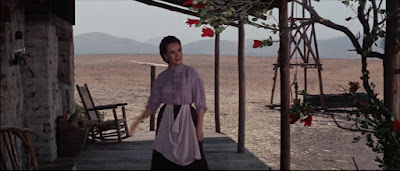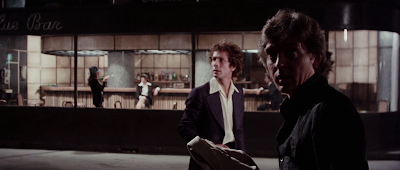When I was a child, one of the very first LPs I got was Elvis Sings Flaming Star (1968) by Elvis Presley. I knew it related to a film because of the cover but as I found out later, it’s a compilation and a mixed bunch at that with a raucous version of Tiger Man from the ’68 Comeback Special, along with a mix of all previously unreleased songs from various of his films recorded between 1960 and 1968. There’s the sublime blues of All I Needed Was the Rain and the rugged Chuck Berry cover, Too Much Monkey Business from Stay Away Joe (1968) (the latter unused), balanced against the saccharine Wonderful World from Live a Little, Love a Little (1968), then the more energetic The Yellow Rose of Texas, Do the Vega and Night Life from Viva Los Vegas (1964) plus the funky She’s a Machine from Easy Come, Easy Go (1967).
I was seven or eight but I knew Elvis was cooler than Herman and the Hermits, Englebert or Cliff… and, as I got older, I became the kind of Elvis snob who bemoans his work after the army years in favour of the Sun Sessions and his more “authentic” rock ‘n roll. Even his films seem to follow the same trajectory with Jailhouse Rock (1957) and King Creole (1957) ahead of almost everything save the hyper-energies of Viva Las Vega (1964) and, bless you Ann-Margaret for that one!
But what of Flaming Star the film? Fifty-odd years
on it was time for me to complete the picture and watch the film of the song
and, whilst that’s a little bit of a depressing stat, I found a lot to admire
in this one and not least, the performance of Elvis Aaron Presley. This film is
perhaps the most serious and dramatic he ever made, dealing as it does with the
issue of mixed-race with Elvis playing Pacer, the son of a white father Sam
"Pa" Burton (John McIntire) and a native American mother, Neddy played
by the sublime Dolores del Río who was born in Mexico. Presley has long been
rumoured to have had native American forebears and this adds an extra edge to a
film that at the time caused some controversy not just in the USA but also in
the British colonies with South Africa initially banning it before showing it
only in segregated cinemas for a white audience only. Elsewhere, the film was
permanently banned in Kenya, Uganda, and Tanzania, with colonial government
officials concerned about the impact on the native community after the Mau Mau
uprisings of the fifties.
The film was indeed bold in its treatment of miscegenation, which was and sadly remains, a hot topic in certain parts of the USA and it’s also nuanced in the ways that racism affects and is part of pretty much every character. Pacer and his elder half-brother Clint (Steve Forrest) are as close as siblings could be but even they are torn by the issue when growing tensions between the local tribes and the white farmers grow and the younger man must decide which side he’s on.
 |
| Steve Forrest, John McIntyre, Barbara Eden, Dolores del Río and The King |
Up till now Pacer has been accepted as part of the community and the film opens with a get-together with the Burtons and their friends including the excellent Barbara Eden as Clint’s sweetheart, Ros Pierce and the always tightly wound Richard Jaeckel as Angus Pierce. After the dinner Angus takes his fiancé Dorothy Howard (Anne Benton) back to her parent’s home only for them to be slaughtered by a raiding party. Angus manages to escape but the incident sparks fear and racial hatred throughout the local community. When Pacer and Clint ride into town they are confronted by Angus and his father (Karl Swenson) as even Ros bitterly suggests that they need to take a side in the face of this brutality.
What makes the film stand out is the fact that there are no two sides here but two cultures in which fear of the other is ingrained; there are lots of decent folk, like Ros and, even Clint, who carry the assumption just below their sense of decency, that the “Indians” are fundamentally less civilised than the whites. On the other side, we see not only the kindness and consideration of Neddy but also her rejection by her own people when she and Pacer go to hear them out. Pacer is also given the same ultimatum by the new chief, Buffalo Horn (Mexican actor, Rodolfo Acosta), who with a long list of grievances, many of his fellows killed by the settlers, reasons the same way as the Pierces.
In the middle of all this acts Elvis and with Don Siegel’s
direction he gives probably his best performance with this grittiest of roles.
He’s believable and committed both physically – all that army training no doubt
helping in the action sequences – but also in the moments between the anger and
action. There’s only one song sung within the film, accompanying himself on
guitar during the get together at the start of the film, and the rest is the
rock star as actor. The pressure was on to include four songs by Siegel resisted
and was at pains to insist that Elvis did not appear professional in this
scene, he played and sang in character and the film is all the better for it…
the audience is reminded what he can do but then get taken down a more challenging
path.
Quentin Tarantino has described this as not only a “truly great” '50s Western but also “… maybe the most brutally violent American Western of its era…” and it doesn’t shy away from some horrific moments and the tension mounts as characters are killed off with some regularity. There’s an uncomfortable moment when two cowboys come to ask for food when Pacer and his mother are alone. They quickly start insulting the “red boy” and his mother and, when Pacer steps out for some wood, try to sexually assault Neddy who repels one of them with a quick thump of her ladle. They encourage the men to go and, without his mother noticing, Pacer goes out the back door to exact instant retribution. Don’t mess with Elvis.
 |
| The divine Delores |
As the film races to its conclusion there will be no easy answers and enough is left unsaid or implied to keep the audience thinking well beyond the end credits. It’s a thoughtful film that ranks alongside even classics such as The Searchers and The Unforgiven in terms of its subject matter if not overall quality. Flaming Star also looks fantastic with cinematography from five-time Academy Award nominee Charles G. Clarke capturing the full breadth of the outstanding locations and Seigel’s vision with characters often silhouetted next to lonesome buildings or staring out across the vast space, vulnerable and alive amidst the backdrop of chaotic humanity.
54 years between the song and the film… who knows where the time goes but this film is certainly worth yours and mine. Happy New Year!























